Guide to capturing firefly images
Have you ever tried capturing light trails from fireflies? If you have not you should definitely give it a try. Fireflies are found in certain areas of Japan, where I live, and in other places around the globe. They are 2 species found in Japan, Genji and Hime. Hime are also called Kin depending on the region but essentially they are the same. Genji glow in a slow pulsating fashion while Hime flash rapidly.
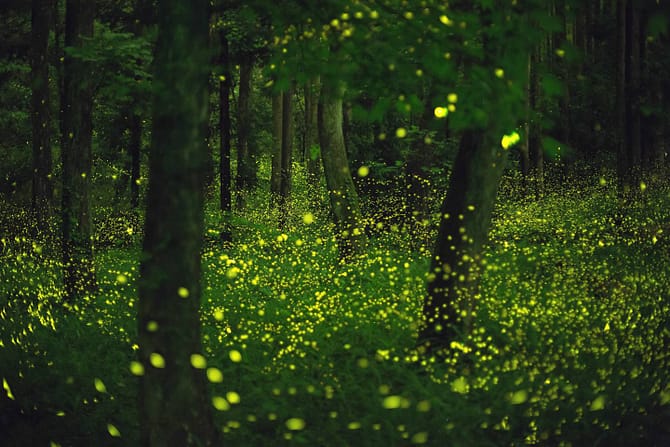
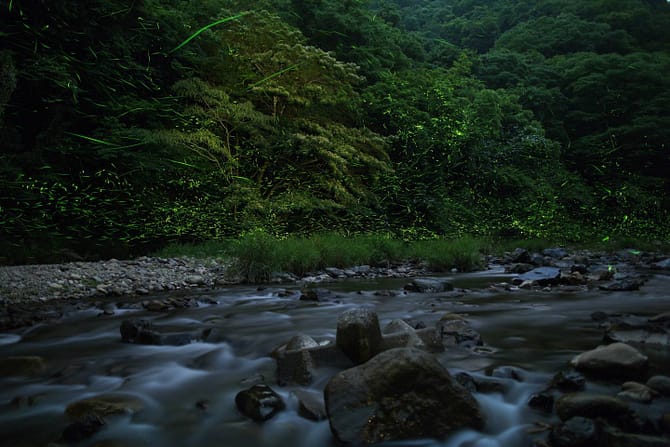
What Do I Need?
Before you head out in to the dark check the list below to make sure you have all the required gear, which is pretty standard for any night photography.
- A camera capable of shooting in “Bulb” mode
- A sturdy tripod
- A cable or shutter release *it can be done with a remote but options will be very limited
Some things that I also bring are some rubber boots as venomous snakes are usually found in the same habitat as fireflies here in Japan.
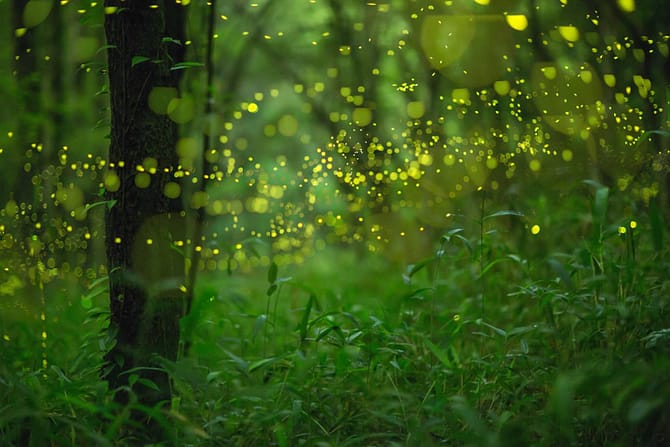
Where Should I Go?
This is something that you will have to research for your region. Fireflies live in certain areas and they simply may not live anywhere near you. In my area Genji are found near areas that have both water and tall grass and Hime are found in damp forests with bamboo grass present. Hime is the rarer breed of the two and are harder to find. The Hime fireflies make much nicer images in my opinion.
You may also want to consider the scenery. Capturing just the light trails on a black background would not be very interesting so nice location is important. Many of the places where you can view fireflies are busy with people who bring cars and other light sources that can ruin the shot. I find searching close by to these places can often yield a decent spot. Again, a little research goes a long way.
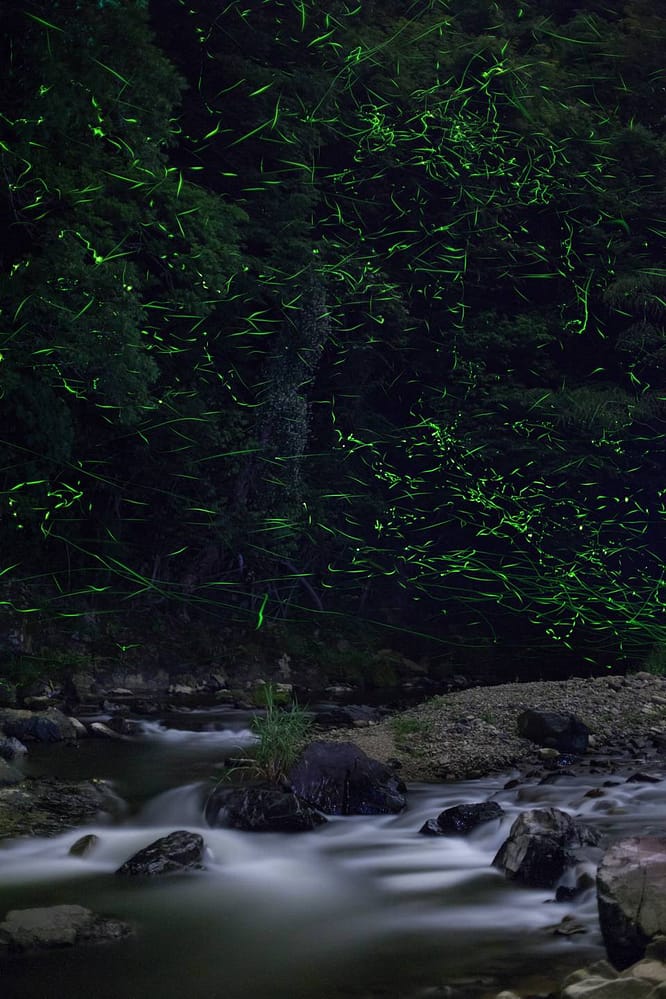
How Do I Get Started?
Before dialing in any settings you should go ahead and mount your camera onto a tripod. Roughly compose your shot and set the focus. In the dark, it is not easy to get the AF to lock on to anything but do not worry, as there are several solutions to this.
Some lenses will have distance markings, but some may not. Make sure to rotate the lens a full turn after infinity and then turn back to the desired distance to get true measurement. Shining a light on the foreground subject while using the AF function may work if the flashlight is bright. If that does not work, go lay the flashlight on the ground at the base of what you are shooting and focus on that. Once you have achieved the glorious state of “in focus”, be sure to set it to MF or manual focus before starting your exposure or it will start searching again when you start the exposure and you will lose your focus and have to repeat the whole process again. Keep in mind that if other photographers are in the area this will ruin a frame or two of theirs.
When I shoot the Genji I am usually using a wide-angle lens. Since these fireflies are more about the bigger picture you are pretty safe to set your focus to infinity. For this species you do not need to be very close to get a nice shot.
For the Hime it is all about the bokeh so I suggest shooting with fast primes, specifically a 35, 50, or 85mm. Getting focus for these will be a little more difficult. To get the bokeh you want to be close to the fireflies.
So now you should have your camera focused and set to manual focus (MF) and the shot roughly composed. When composing the shot try not to include any direct light sources (e.g. streetlights) in the shot.
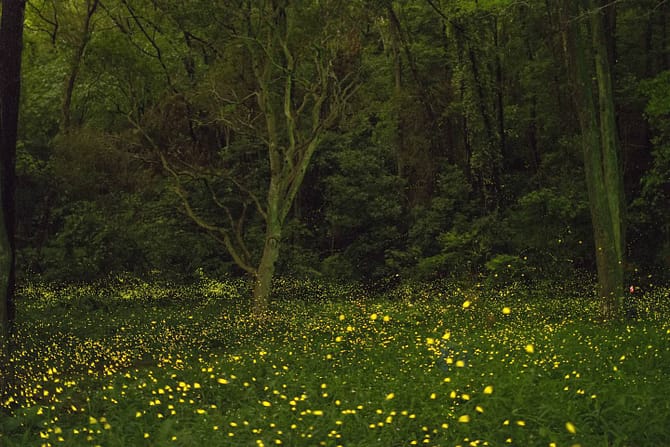
Let’s Get To The Good Stuff
Basically, shooting fireflies is just like shooting start trails. It is much easier to capture shorter frames and then stack them after into one final image. There are many advantages to this method including reducing noise but settings for capturing low light are needed and over time the background would just get too bright. Shooting hour-long exposures on a DSLR is just not practical.
First things first, you will need to check your composition with a test shot. Run a 1 or 2 minute exposure at a high ISO to check your frame and focus. Repeat until you are happy.
Next I work on what I think of as my ‘base’ background. This is the most important frame and it needs to be the right exposure. For me, the right exposure is about -1 or -2 stops. It should be dark enough to its night and for the trails to show up on the background. If needed, increase the ISO or extend the shutter speed to get a decent shot in terms of brightness. Camera noise is the worst when the image is under exposed but the blacks are not clipped. Test and repeat until you have a decent base image to work with. This image may be 1 minute or much more. You will need to be in BULB mode for this.
Next you need to shoot for the stack. I have discovered that shorter exposures that clip all blacks and have nothing else but the firefly glow in them yield the cleanest images in terms of noise. Noise generally increases with time so you only have to worry about 30 seconds that means even at a higher ISO it is not really going to cause a problem. For starters, try f/2, ISO 400 for 30 seconds. You can adjust from these by increasing the ISO but you are really only trying to catch the firefly trails. I generally switch my camera to MANUAL mode and dial in 30 seconds and lock a cable release and let it do its thing. You will need to have your camera set to continuous shooting mode for this.
I suggest running your shooting for about 30-45 minutes. This all depends on firefly activity of course. I find that any longer than this becomes too much. You end up with a frame that is filled with abstract light trails that block all scenery in the frame and just seems to lose any visible subject matter.
So just repeat this above process until it is time to head home to bed. Try and get as many compositions as possible to make the most out of your trip!
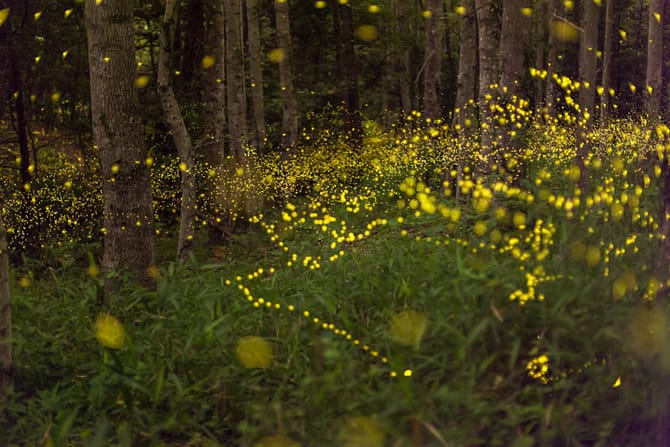
How to Stack the Photos
So now you have a memory card filled with image sequences and you are going to use software to stack them up to create your final firefly picture. There are several free options for this each has easy instructions on their respective homepages that guide you on how to use each one.
I generally start by importing my pictures into Lightroom and then using color tags separate them into their respective “stacks”. By stacks I am referring to the one base exposure with all the following shorter frames shot for that composition. Make whatever adjustments you wish and export them into separate folders. You can generally really only need to edit the base frame as the others are usually black with just some light trails.
There are two options for assembling the final stack. Photoshop is one option but it is quite time consuming. There are some actions that could speed up the process like the Photoshop Stacking action.
The option that I prefer is StarStaX. What I like about StarStaX is the incredible speed. It is waaaay faster than using Photoshop and much easier as it does not require you to create any blank documents to get started. Open up the program and import your images. Hit start and within seconds your image is finished.
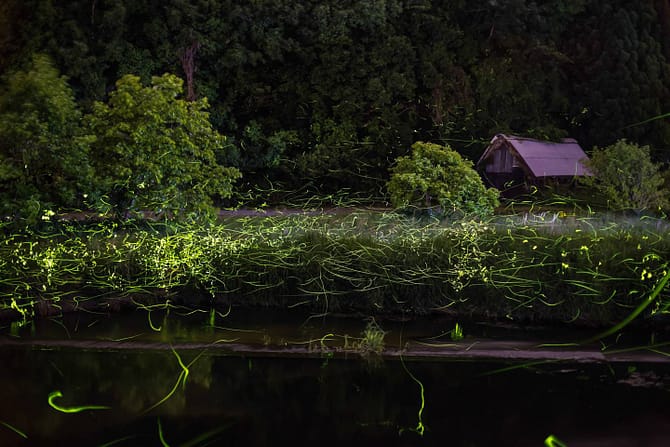
Whatever method you choose you may find that some of the trails in the finished image are out of place or sort of ruin the shot. Genji fireflies often prefer a certain tree in the frame so that area of the frame simply has too many trails and is not visually appealing. Finding the frames with misplaced trails or intense areas and blacking them out with an adjustment brush in Lightroom can easily fix this. Export the adjusted frames back into the respective folder and then run that folder through the StarstaX again. Repeat until you are happy with what you have.
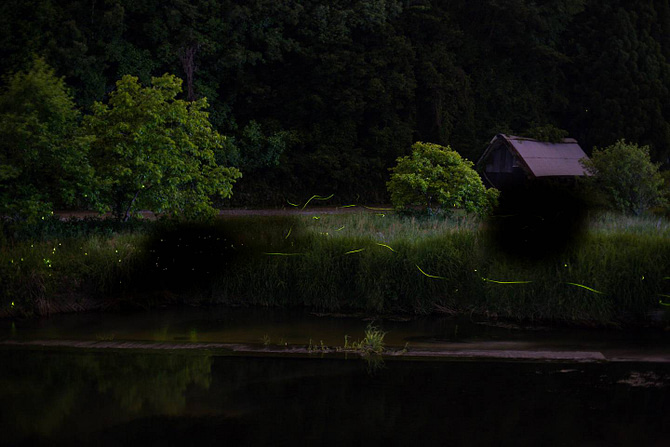
Once you have your stacked image save it and drop it into your favorite editing program to continue editing if you wish. One thing worth mentioning is that these creatures live in grass or forests making the images full of green. Auto white balance compensates for this by heavily increasing the magenta. You may want to check for this in your final image. This is fixed by simply reducing the magenta in the final image.
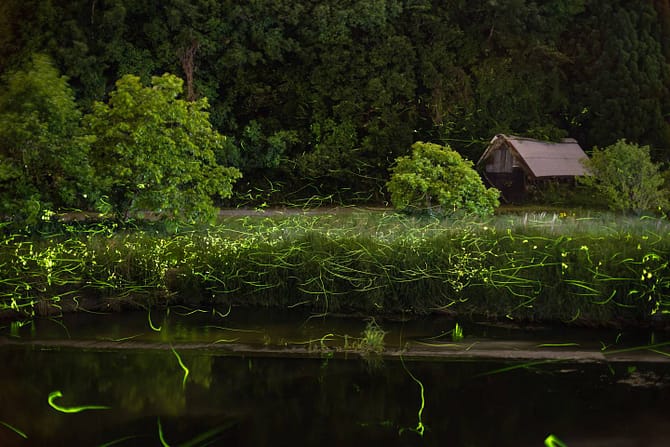
Now that you know how to capture them one last important point is conservation. When photographing them we are essentially invading their territory. They are glowing during their mating season and it is important we respect their environment. Treading on eggs and stomping on the breeding grounds is not sustainable. Please keep this in mind and stick to known paths and just being conscious of where you are walking and what you are stepping on. Without any conservation effort they will just decrease every year…
Shooting fireflies is similar to shooting star trails. It is a short season every year dependent on temperature which makes them somewhat elusive and a little exciting to photograph. If it is something you have not tried yet check online to find where the closest place is to you and go give it a try.
Feel free to share this post via the social media buttons on the left. A selection of my firefly images can be licensed for commercial use in my Getty Images portfolio. If you are interested in republishing this somewhere please contact us for info on how to make that happen smoothly.

